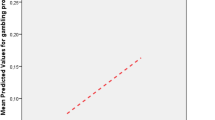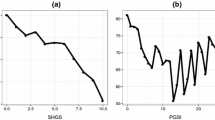Abstract
The Northern Territory of Australia, one of the most demographically and socially diverse jurisdictions in the country, conducted its first population-based gambling and problem gambling prevalence survey in 2005. Both the South Oaks Gambling Screen (SOGS) and the Canadian Problem Gambling Index (CPGI) were administered to the same sample of respondents. Using data from this survey, the current paper presents a parallel comparison of the respective screens with particular reference to gender, region, and the socio-demographic characteristics of respondents. The respective screens produced significantly different groups of problem gamblers as measured by their association with a range of socio-demographic variables. Specifically, the large number of SOGS items related to money issues may cause selective overrepresentation among low socioeconomic groups, including Indigenous people, who exist in relatively high proportions in the Northern Territory. In addition, there existed substantial gender-based differences within screens. Identified female problem gamblers were associated with household level variables (i.e. employment status, household type and marital status), while males were associated with socio-economic variables including language, education, and income. Further research is required to validate the use of problem gambling screens within the Indigenous population and to understand the role of gender in the experience and categorisation of problem gambling.
Similar content being viewed by others
References
Ames, B., Bell, T., & Firman, D. (2004). Gambling in an Indigenous community: Report on the Cherbourg Research Project. In 12th Annual Conference of the National Association of Gambling Studies: Melbourne.
Australian Bureau of Statistics. (2002a). Census of population and housing: Selected social and housing characteristics for Statistical Local Areas, Northern Territory, 2001. Cat. No. 2015.7. Canberra: ABS.
Australian Bureau of Statistics. (2002b). Population distribution, Aboriginal and Torres Strait Islander Australians, 2001. Cat. No. 4705.0. Canberra: ABS.
Australian Bureau of Statistics. (2003a). Census of population and housing: Selected education and labour force characteristics for Statistical Local Areas, Northern Territory, 2001. Cat. No. 2017.7. Canberra: ABS.
Australian Bureau of Statistics. (2003b). Population characteristics, Aboriginal and Torres Strait Islander Australians, 2001. Cat. No. 4713.0. Canberra: ABS.
Australian Bureau of Statistics. (2003c). Census of population and housing: Selected education and labour force characteristics for Statistical Local Areas, Australia, 2001. Cat. No. 4017.0. Canberra: ABS.
Australian Bureau of Statistics. (2004a). General Social Survey, Northern Territory, 2002. Cat. No. 4159.7.55.001. Canberra: ABS.
Australian Bureau of Statistics. (2004b). General Social Survey: Summary results, Australia, 2002. Cat. No. 4159.0. Canberra: ABS.
Australian Bureau of Statistics. (2004c). National Aboriginal and Torres Strait Islander Social Survey, Northern Territory, 2002. Cat No. 4714.7.55.001. Canberra: ABS.
Australian Bureau of Statistics. (2007). Regional population growth, Australia. Cat. No. 3218.0. Canberra: ABS.
Battersby, M. W., Thomas, L. J., Tolchard, B., & Esterman, A. (2002). The South Oaks Gambling Screen: A review with reference to Australian use. Journal of Gambling Studies, 18, 257–271.
Blanco, C., Hasin, D., Petry, N. M., Stinson, F., & Grant, B. F. (2006). Sex differences in subclinical and DSM-IV pathological gambling: Results from the National Epidemiologic Survey on alcohol and related conditions. Psychological Medicine, 36, 943–953.
Clarke, D., Abbott, M., Tse, S., Townsend, S., Kingi, P., & Manaia, W. (2006). Gender, age, ethnic and occupational associations with pathological gambling in a New Zealand urban sample. New Zealand Journal of Psychology, 35, 84–91.
Currie, S. R., Hodgins, D. C., Wang, J. L., El Guebaly, N., Wynne, H., & Chen, S. (2006). Risk of harm among gamblers in the general population as a function of level of participation in gambling activities. Addiction, 101, 570–580.
Dannon, P. N., Lowengrub, K., Shalgi, B., Sasson, M., Tuson, L., Saphir, Y., & Kotler, M. (2006). Dual psychiatric diagnosis and substance abuse in pathological gamblers: A preliminary gender comparison study. Journal of Addictive Diseases, 25, 49–54.
Delfabbro, P. (2000). Gender differences in Australian gambling: A critical analysis of sociological and pathological research. Australian Journal of Social Issues, 35, 145–157.
Duvarci, I., Varan, A., Coskunol, H., & Ersoy, M. A. (1997). DSM-IV and the South Oaks Gambling Screen: Diagnosing and assessing pathological gambling in Turkey. Journal of Gambling Studies, 13, 193–206.
Feise, R. J. (2002). Do multiple outcome measures require p-value adjustment? BMC Medical Research Methodology, 2, 8–12.
Ferris, J., & Wynne, W. (2001). The Canadian Problem Gambling Index: Final report. Ontario: Canadian Centre on Substance Abuse.
Gill, T., Dal Grande, E., & Taylor, A. W. (2006). Factors associated with gamblers: A population-based cross-sectional study of South Australian adults. Journal of Gambling Studies, 22, 143–164.
Ladouceur, R., Bouchard, C., Rheaume, N., Jacques, C., Ferland, F., Leblond, J., & Walker, M. (2000). Is the SOGS an accurate measure of pathological gambling among children, adolescents and adults? Journal of Gambling Studies, 16, 1–24.
LaPlante, D. A., Nelson, S. E., LaBrie, R. A., & Shaffer, H. J. (2006). Men & women playing games: Gender and the gambling preferences of Iowa gambling treatment program participants. Journal of Gambling Studies, 22, 65–80.
Ledgerwood, D. M., & Petry, N. M. (2006). Psychological experience of gambling and subtypes of pathological gamblers. Psychiatry Research, 144, 17–27.
Lesieur, H. R., & Blume, S. B. (1987). The South Oaks Gambling Screen (SOGS): A new instrument for the identification of pathological gamblers. American Journal of Psychiatry, 144, 1184–1188.
McMillen, J., Marshall, D., Ahmed, E., & Wenzel, M. (2004). Victorian Longitudinal Communities Attitudes Survey: Report for the gambling research panel. Melbourne: Department of Justice, Victorian Government.
McMillen, J., & Wenzel, M. (2006). Measuring problem gambling: Assessment of three prevalence screens. International Gambling Studies, 6, 147–174.
Memmott, P., Long, S., & Thomson, L. (2006). Indigenous mobility in rural and remote Australia: Final report. Queensland: Australian Housing and Urban Research Institute.
Neale, P., Delfabbro, P., & O’Neil, M. (2005). Problem gambling and harm: Towards a national definition. Victoria: The SA Centre for Economic Studies.
Nelson, S. E., LaPlante, D. B., LaBrie, R. A., & Shaffer, H. J. (2006). The proxy effect: Gender and gambling problem trajectories of Iowa gambling treatment program participants. Journal of Gambling Studies, 22, 221–240.
Orford, J., Sproston, K., & Erens, B. (2003). SOGS and DSM-IV in the British Gambling Prevalence Survey: Reliability and factor structure. International Gambling Studies, 3, 53–65.
Paterson, M. (2006). A future now; not a past too late: An analysis of Aboriginal gambling in Australia. In National Association of Gambling Studies 16th Annual Conference, 25th November 2006, Sydney.
Perneger, T. V. (1998). What’s wrong with Bonferroni adjustments. British Medical Journal, 316, 1236–1238.
Petry, N. (2002). A comparison of treatment-seeking pathological gamblers based on preferred gambling activity. Addiction, 98, 645–655.
Productivity Commission. (1999). Australia’s gambling industries: Inquiry report no.10. Canberra: AusInfo.
Queensland Government. (2005). Queensland Household Gambling Survey 2003/04. Brisbane: Queensland Treasury.
Roy Morgan Research. (2006). The fourth study in the extent and impact of gambling in Tasmania with particular reference to problem gambling. Report to the Gambling Support Bureau, Department of Health and Human Services. Hobart: Tasmanian Government.
Schofield, G., Mummery, K., Wang, W., & Dickson, G. (2004). Epidemiological study of gambling in the non-metropolitan region of Central Queensland. Australian Journal of Rural Health, 12, 6–10.
Scull, S., & Woolcock, G. (2005). Problem gambling in non-English speaking background communities in Queensland, Australia: A qualitative exploration. International Gambling Studies, 5, 29–44.
Stevens, M., & Young, M. (in press). Gambling screens and problem gambling estimates: A parallel psychometric assessment of the SOGS and CGPI. Gambling Research, forthcoming.
Stinchfield, R. (2002). Reliability, validity, and classification accuracy of the South Oaks Gambling Screen (SOGS). Addictive Behaviors, 27, 1–19.
Thompson, A., Walker, M., Milton, S., & Djukic, E. (2005). Explaining the high false positive rate of the South Oaks Gambling Screen. International Gambling Studies, 5, 45–56.
Volberg, R. A. (2002). Gambling and problem gambling in Nevada. Northampton: Gemini Research.
Walker, M., & Dickerson, M. (1996). The prevalence of problem and pathological gambling: A critical analysis. Journal of Gambling Studies, 12, 233–249.
Welte, J. W., Barnes, G. M., Wieczorek, W. F., Tidwell, M. C., & Parker, J. C. (2004). Risk factors for pathological gambling. Addictive Behaviors, 29, 323–335.
Wenzel, M., McMillen, J., Marshall, D., & Ahmed, E. (2004). Validation of the Victorian Gambling Screen. Melbourne: Centre for Gambling Research, ANU.
Wilson, T., & Condon, J. R. (2006). Indigenous population change in the Northern Territory 1966 to 2031. People and Place, 14, 65–78.
Young, M., Abu-Duhou, I., Barnes, T., Creed, E., Morris, M., Stevens, M., & Tyler, B. (2006). Northern Territory Gambling Prevalence Survey 2005. Darwin: School for Social and Policy Research.
Young, M., Barnes, T., Stevens, M., Paterson, M., & Morris, M. (2007). The changing landscape of Indigenous gambling in Northern Australia: Current knowledge and future directions. International Gambling Studies, 7, 327–347.
Acknowledgements
The authors wish to acknowledge the Community Benefit Fund of the Northern Territory Government for funding the research and thank Dr. William Tyler for helpful suggestions on a previous draft of this paper.
Author information
Authors and Affiliations
Corresponding author
Rights and permissions
About this article
Cite this article
Young, M., Stevens, M. SOGS and CGPI: Parallel Comparison on a Diverse Population. J Gambl Stud 24, 337–356 (2008). https://doi.org/10.1007/s10899-007-9087-z
Received:
Accepted:
Published:
Issue Date:
DOI: https://doi.org/10.1007/s10899-007-9087-z




